Note
the actual ooc answer is that as far as i can see pokemon animal taxonomy should be just about the same as real world animal taxonomy (save for a few additions such as the hexapodal dragons) so puffins would still like, be a thing in the pokemon world, they'd just be pokemon puffins and not real puffins, you know? like, how there are snakes in the pokemon world, they're just ekans, seviper, snivy etc. those pokemon are still snakes because they're animals within serpentes.
essentially, the only reason i just said "puffins" and not "puffins such as [x pokemon name]" is because there isn't an official puffin pokemon as of yet, but i'm operating on the assumption that there are some species of puffin pokemon somewhere out there in the pokemon world, if that makes sense.
what's a puffin
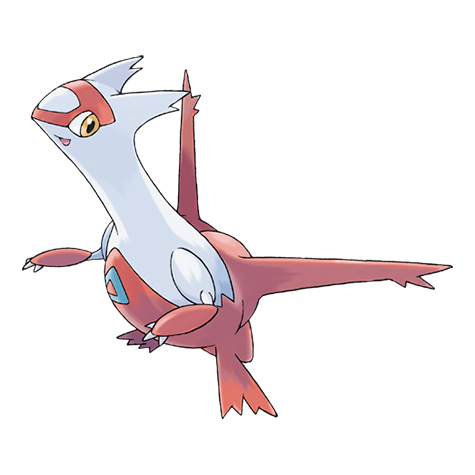
29 notes
·
View notes
Note
Hello! Trainer from Alola here, big fan of your work. I was wondering; is there any evidence of any legendary pokemon being related to other pokemon? For example, does Rayquaza share any DNA with other dragon pokemon? (I know it would be extremely difficult to get any rayquaza DNA fhshfjd) Or are pokemon like that entirely their own species?
the answer is, as with many things on this blog.. it depends!
"legendary pokemon" aren't really a cohesive category like, say, a type or a taxonomic group. the only common factors are that they tend to be very rare and that they have legends about them. as our examples, let's use two groups of hoenn legendary pokemon: latios and latias, and groudon, kyogre, and rayquaza.
latios and latias (like other pairs such as nidoqueen and nidoking, or volbeat and illumise, latios and latias are sexually dimorphic members of the same species) are indeed related to other pokemon- they're birds! specifically, they're in the auk family, which are a group of generally stout, seafaring birds like guillemots and puffins. this may seem strange- the latis appear to have wings and arms, and no legs, very unlike birds. however, if we take a look at their skeleton, the connection becomes much more obvious:

what we generally interpret as arms are actually the lati's legs, the thighs of which are obscured by flesh and feathers. while they use their wings to steer and for some lift, the latis generally stay aloft with their psychic powers rather than traditional flight, which is why they can hover in place. this has freed up their legs for use in manipulating objects, and they are rarely seen standing on their feet. because they mostly rely on hovering, their legs no longer have the strength to hold their large bodies up for very long.
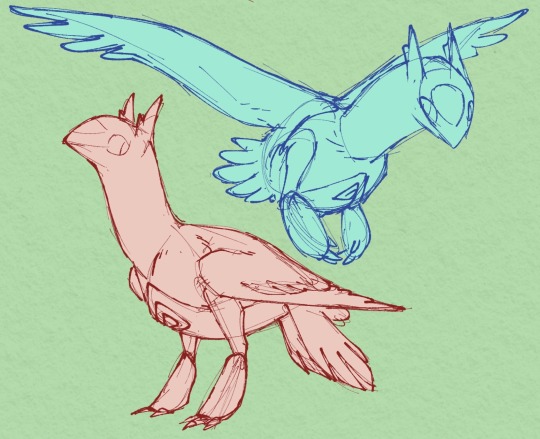
these pokemon are indeed exceptionally rare, having very low population numbers in only a few regions, and spending most of their time over open ocean. like many pelagic seabirds, they breed on only a few small islands, like alto mare off the johto region and southern island off hoenn's south coast. their populations are on the upswing, though, in large part due to concentrated conservation efforts on those islands. point being, though, they are indeed just animals. rare, powerful animals, but animals nonetheless.
many legendary pokemon fall into this camp. articuno, zapdos, and moltres, lugia and ho-oh, heatran, and various others.
.
conversely, the so-called weather trio of hoenn: groudon, kyogre, and rayquaza. these three are even more rarely seen than the latis, only having been sighted in recent times during their clash in hoenn nearly two decades ago. despite the three's resemblance to other living pokemon, as far as we know they are entirely unrelated to any known animals, or even any other life on earth.
this is known because evidence of these pokemon have been found dating back over 3 billion years ago, that is to say over a billion years before multicellular life even existed. gigantic fragments of footprints attributed to groudon have been sighted alongside some of the earliest fossils we know of of early bacteria. modern physical samples from these pokemon- the extremely few that have ever been recovered- have never resulted in any dna evidence, and appear in structure much more similar to inorganic matter.
as it stands, it appears these pokemon arose some time early (relatively speaking) after the earth formed, being (as opposed to natural living organisms) animate representations of the forces of nature themselves. a similar condition is often assumed for some other grandiose legendary pokemon, such as dialga and palkia, though much less tangible evidence exists for their presence in prehistoric time, so this is mostly an assumption based on their infrequent appearances & legends surrounding their origins.
426 notes
·
View notes
Text
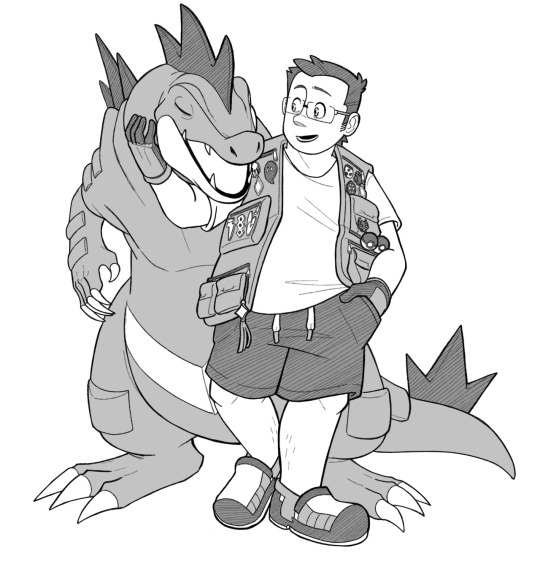
OH I NEVER POSTED THIS!! a while back i got a commission from the incredible @waywardstation for this blog!! i'm still so blown away by this, it's awesome.
186 notes
·
View notes
Text
ignore that i disappeared for half a year. hi
28 notes
·
View notes
Note
Hello! Trainer from Alola here, big fan of your work. I was wondering; is there any evidence of any legendary pokemon being related to other pokemon? For example, does Rayquaza share any DNA with other dragon pokemon? (I know it would be extremely difficult to get any rayquaza DNA fhshfjd) Or are pokemon like that entirely their own species?
the answer is, as with many things on this blog.. it depends!
"legendary pokemon" aren't really a cohesive category like, say, a type or a taxonomic group. the only common factors are that they tend to be very rare and that they have legends about them. as our examples, let's use two groups of hoenn legendary pokemon: latios and latias, and groudon, kyogre, and rayquaza.
latios and latias (like other pairs such as nidoqueen and nidoking, or volbeat and illumise, latios and latias are sexually dimorphic members of the same species) are indeed related to other pokemon- they're birds! specifically, they're in the auk family, which are a group of generally stout, seafaring birds like guillemots and puffins. this may seem strange- the latis appear to have wings and arms, and no legs, very unlike birds. however, if we take a look at their skeleton, the connection becomes much more obvious:

what we generally interpret as arms are actually the lati's legs, the thighs of which are obscured by flesh and feathers. while they use their wings to steer and for some lift, the latis generally stay aloft with their psychic powers rather than traditional flight, which is why they can hover in place. this has freed up their legs for use in manipulating objects, and they are rarely seen standing on their feet. because they mostly rely on hovering, their legs no longer have the strength to hold their large bodies up for very long.

these pokemon are indeed exceptionally rare, having very low population numbers in only a few regions, and spending most of their time over open ocean. like many pelagic seabirds, they breed on only a few small islands, like alto mare off the johto region and southern island off hoenn's south coast. their populations are on the upswing, though, in large part due to concentrated conservation efforts on those islands. point being, though, they are indeed just animals. rare, powerful animals, but animals nonetheless.
many legendary pokemon fall into this camp. articuno, zapdos, and moltres, lugia and ho-oh, heatran, and various others.
.
conversely, the so-called weather trio of hoenn: groudon, kyogre, and rayquaza. these three are even more rarely seen than the latis, only having been sighted in recent times during their clash in hoenn nearly two decades ago. despite the three's resemblance to other living pokemon, as far as we know they are entirely unrelated to any known animals, or even any other life on earth.
this is known because evidence of these pokemon have been found dating back over 3 billion years ago, that is to say over a billion years before multicellular life even existed. gigantic fragments of footprints attributed to groudon have been sighted alongside some of the earliest fossils we know of of early bacteria. modern physical samples from these pokemon- the extremely few that have ever been recovered- have never resulted in any dna evidence, and appear in structure much more similar to inorganic matter.
as it stands, it appears these pokemon arose some time early (relatively speaking) after the earth formed, being (as opposed to natural living organisms) animate representations of the forces of nature themselves. a similar condition is often assumed for some other grandiose legendary pokemon, such as dialga and palkia, though much less tangible evidence exists for their presence in prehistoric time, so this is mostly an assumption based on their infrequent appearances & legends surrounding their origins.
426 notes
·
View notes
Note
Any info/speculation on Stakataka (or any of the other UBs)? I’m not sure if they’re an exceptionally large colony organism a la algae or fungi, or a really weird pack animal.
All the pokedex says is that it’s roughly 150 lifeforms, but that doesn’t tell me if each Stakataka block is behaving like a cell that’s defying the Square law or if they’re more like wishiwashi
thing is, concrete data on any of the ultra beasts is pretty few and far between. their appearances are so rare, and ultra wormhole events so potentially destructive, that safety and containment by law enforcement that scientific data generally comes second. in addition, ultra beasts are by definition from another dimension entirely, so their evolution and classification may very well be entirely separate from the kingdom of life as we know it on earth.
as an example, take a gander at pheromosa/UB02 BEAUTY. it appears insectiod, certainly, most resembling a cockroach. we have no reason to think, however, that this is due to the UB actually being an insect, rather it could be an entirely different sort of organism that convergently resembles the surface-level features of a cockroach. ultra space is a world separate from our own, and we don't know how life developed there- if it arose organically just like on earth, with unicellular life taking shape in some primordial soup- or if it could have been "seeded"- an ancient ultra wormhole allowing organisms from our world to travel into the dimension where the ultra beasts hail from, which adapted into entirely new forms in that new environment. currently, we just don't know enough about them to say.
stakataka (or UB: ASSEMBLY, if you prefer) does indeed appear to be a conglomerate pokemon, composed of multiple individuals. if i had to guess, based on its rock/steel typing, i would say that it is likely to be an inorganic pokemon, much like our magnemite or bronzor. we do know that at least part of their bodies are made up of inorganic metal. how the individuals communicate and whether they could live independently of one another or if they're inextricably connected is unfortunately yet unknown.
#pkmn#pkmn irl#sorry for the lack of updates recently! been working on some life stuff. and being really invested in a new show#ive got another ask mostly typed out as well#pkmn rp
37 notes
·
View notes
Text
everybody needs to read this RIGHT now

#pkmn#pkmn irl#pkmn rp#save#this is so good this is so well done. i dont have anything to add its just Good
3K notes
·
View notes
Text

3K notes
·
View notes
Note
Hello, saw your post about fox pokemon. What exactly are eevee? Always grouped 'em in with fox pokemon. Are they atleast canine like?
that's more of a loaded question than you might think! for a very long time, where eevee rests on the mammalian family tree is the sort of thing you could ask 10 biologists and get 13 answers, and maybe a shouting match. eevee has wildly variable internal features that make placing it in a certain spot really difficult- i'm talking like minute differences in the shapes of bones that would usually be used to identify certain groups. you might think that with the discovery of dna we'd be able to definitively place it where it belongs, but eevee's genetic makeup is remarkably plastic (changeable) and unstable. there's even quite a bit of research looking into cancer prevention based on its genome because of that (the species isn't immune to cancer, but has a much lower incidence of it than you'd expect given its penchant for frequent mutation).

so, let's talk about some mammals! particularly, a large group called the carnivora.
(note that "carnivora" or "carnivoran" sound similar to but do not mean the same thing as "carnivore". carnivores are any animal that eats meat, while carnivorans (members of the carnivora) belong to a specific branch of the mammal family tree. most carnivorans are indeed carnivores, but not all.)
so, carnivora! almost every person that's proposed a place on the mammalian family tree for eevee has placed it in or near the carnivorans. it's a group that is made up of two smaller clades: the feliforma (the cat-like carnivorans) and the caniforma (the dog-like carnivorans). the feliforma includes groups like the cats, hyenas, and mongooses. the caniforma includes groups like the dogs, bears, weasels, and seals.

some examples of the feliforms on the left, and caniforms on the right. of the feliforms we have pyroar and meowstic (cats), mightyena (a hyena), and yungoos (a mongoose). of the caniforms we have houndour (a dog), buizel (an otter), sealeo (despite the name, it is a walrus), ursaring (a bear), and zorua (a fox). you hear that right, mightyena is closer to a cat than a dog, and yungoos is entirely unrelated from mustelids (ie weasels, otters, badgers) like buizel or furret.
for an example of what i mean with the thing about eevee's weird morphology defying classification- there's this bit of bone on either side of the bottom of the mammalian skull called the "tympanic bulla" (basically just "Ear Balloon", since it's a hollow chamber). caniforms have only one chamber in their ear balloons, and feliforms have two chambers. eevee has.. both, somehow. if you took 2 eevee skulls and looked at their tympanic bullae, you might find that one has one chamber and one has two. that's.. really weird, just so everybody knows. that sort of thing isn't something you see in basically anything but eevee, same goes for its wildly variable genome.
so, is eevee a caniform, a feliform, or something else? our best answer came in the form of three extremely well-preserved fossils from the johto region, dating back to about 44 MYA, just a few million years before the feliform and caniform branches actually separated.
three pokemon were found, exceptionally preserved- including soft tissues!-, all together. they'd been buried in a mudslide and fossilized right next to/on top of each other, the mineral content of the soil just right to discourage bacterial growth, allowing the soft tissues to stay intact and fossilize as-is.
the fossils were collected and CT scanned to see the bones within the mineralized soft tissues- each of the three individuals appeared to be the same species, with near-identical skeletons. none of the skeletons showed type characteristics (like lignin or metallic structure), making type hard to discern. but what we could tell from the bones is that these were animals just outside of the carnivora- closely related to the ancestors of all carnivorans. and excitingly, they bared a close resemblance to a few skeletal features found only in eevee.
despite the homogeneity of their bones, the fossilized pokemon's soft tissues differed- the fur, in color and pattern (the fossilized fur no longer retains its color, but by looking at microscopic pigment cells within preserved fur and feathers we can deduce color and pattern!) and certain organs- around the throat area, each individual had an elemental organ like many pokemon today use to fuel and store energy for their typed attacks. each of the three fossilized pokemon's throat organ was different in elemental specialization: one fire, one water, and one electric.
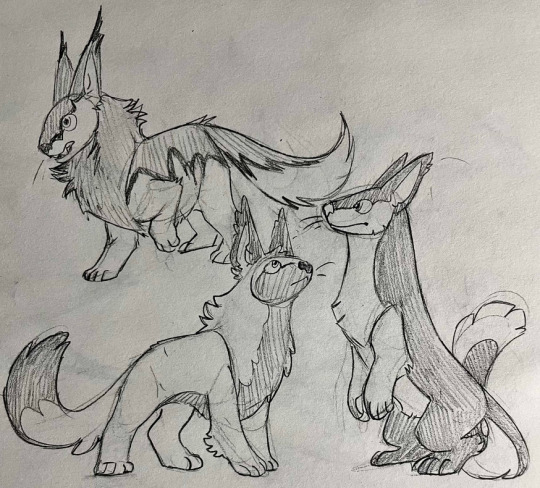
(reconstructions of the three pokemon in question. top electric, left fire, and right water.)
see where i'm going, here? it's unknown if the three individuals represent three different evolutions, or three differently typed forms (like oricorio) of a singular pokemon, and a pre-evolved form is not yet known, if it existed at all. but we can say with some confidence that these guys may well have been ancestors of eevee as we know it today, which places eevee within the non-carnivoran carnivoraforms- something that emerged before the feliforma and caniforma existed, with traits found in both and found in neither.
383 notes
·
View notes
Text
I realize it’s just because they’re trying to introduce the audience to the concept of Pokemon and everything but nothing will ever be funnier to me than prof oak being like “these are creatures called Pokemon, they live in all sorts of environments!” like imagine if you met a biology professor and they were like ‘I’ve been studying these intriguing creatures called “animals’
97K notes
·
View notes
Note
(@icetypelover) Hello, since biology is your thing I wanted to ask, how uncommon is a mutation where a Pokémon has two heads? I've seen it happen in Ekans and similar Pokémon rarely, but someone I know has a two-headed Houndoom, he was born with them. He's a gift from her father, back when he was a little Houndour pup, he's very well raised and gentle, though some fire can leak from his mouth when he's excited.
He's from a family of breeders who have been working with her father's family for generations where Houndoom are a Pokémon of choice, and they can't remember if it has ever happened before. The heads don't snap at each other and he's given a bit more food than a Houndoom his size would need since he has two brains, split in half so each head can eat, and he has no health issues.
I'm curious because there are two mythos I know, of Houndoom-like creatures with two and three heads, so it has to come from somewhere right? Since they're both represented as similar to Houndoom, does that mean it's maybe a mutation that can happen not so impossibly rare you wouldn't believe it in Houndoom?
wow, that's very fortunate that the fellow's gotten one just fine with two heads! extremely cool, what an exceptional lil guy, i'm glad the two get along.
polycephaly (literally "multiple headed") is a condition found all over the animal kingdom- including in humans!- and it isn't actually a mutation (with a notable exception we'll get to later). mutations specifically refer to changes in the genetic code- whether that's the flipping of a base pair, duplication of chromosomes, or so on- while polycephaly is actually a way that conjoined twinning can be expressed.
so, identical twins. identical (also called monozygotic) twins happen when a fertilized egg splits into two separate wholes at some point early in development- compare with "typical" development, where 1 egg + 1 sperm = 1 baby. identical twins happen when 1 egg + 1 sperm = 2 baby. compare with fraternal (or dizygotic) twins, which are formed from two separate eggs fertilized by two separate sperm. identical twins share a genetic code while fraternal twins do not (like any other sort of sibling). identical twins aren't super uncommon, though their rate of occurrence changes depending on where in the world you go.
now, usually this separation of the zygote into 2 embryos is complete. rarely, though, this splitting happens particularly late and doesn't quite finish, resulting in the two twins being connected in some fashion. this can result in an organism with one body and two heads, such as in your houndoom example, but can express in tons of different ways- for example, you may be familiar with the term "siamese twins" for conjoined twins: this originates from a famous pair of conjoined human twins from 1800's siam, chang and eng bunker, who were joined around the chest. in other cases, twins can be fused at the back of the head, the abdomen, the back, and plenty of other configurations.
survivability of these conditions varies wildly. some are easily separated, some live fine while conjoined, some must be separated for either of the two to survive, and unfortunately some are unable to survive at all, dying soon after birth.
the last case is usually what happens with two-headed organisms (something something, twice as many stars), but obviously, there are exceptions. while rare, organisms (of any sort- it's most famous in reptiles as you mentioned, but mammals (including humans!) can obviously exhibit it too) can live with these conditions as well.
also worth noting- when two complete heads are present, two complete brains are present! they may share organs and sensation, but the brains do function independently- so it's good that in your example the two get along! two-headed examples of less social species will often be much more antagonistic towards one another, since the two heads can recognize their counterparts as potential competitors or aggressors. this can cause problems in wild pokemon, who may waste precious time and energy squabbling over who gets to eat something that's going to the same stomach anyways (assuming the individuals share a stomach- sometimes there are two), leaving them vulnerable to attack.
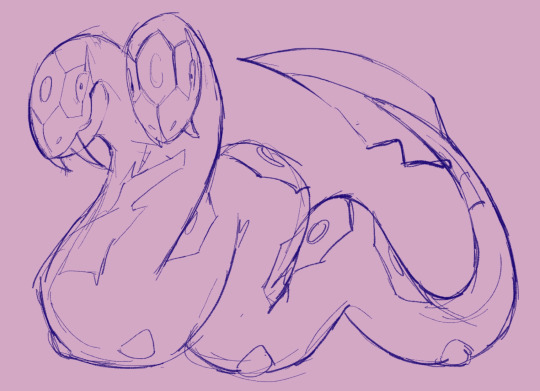
(you may be familiar with 12-string, a polycephalic seviper(s) owned by virbank gym leader roxie, who famously featured in some particularly intense PWT matches- two heads means two sets of venom glands, which means REALLY effective poison type attacks!)
this also raises the question of individuality- whether polycephalic organism(s) are considered one or two beings- and perspectives on this vary. some polycephalic twins consider themselves two separate people, while some consider themself one. in what way you consider polycephalic organisms without the ability to self-define in that way is up to you, really (which is to say, if a person with two heads considers themself one person, they are one person, and vice versa, but most nonhuman animals can't decide that for themselves and probably don't care how you refer to them).
now, uh, back to pokemon specifically, and those notable exceptions i mentioned. while polycephaly is exceptional in the vast majority of species, there are of course a few where having multiple heads is the norm: doduo/dodrio, deino/zweilous/hydreigon, and girafarig/farigiraf (there are a few others- like weezing or cherubi- but i'm talking about animals specifically here. also not to be confused with conglomerate pokemon like dugtrio or magneton, which are multiple separate individuals working as one). these instances are indeed genetically programmed.
the mechanism by which these pokemon develop their multiheadedness varies. doduo could be considered to be a conjoined twin- the zygote's partial split happens in much the same way, though enforced by genetics.
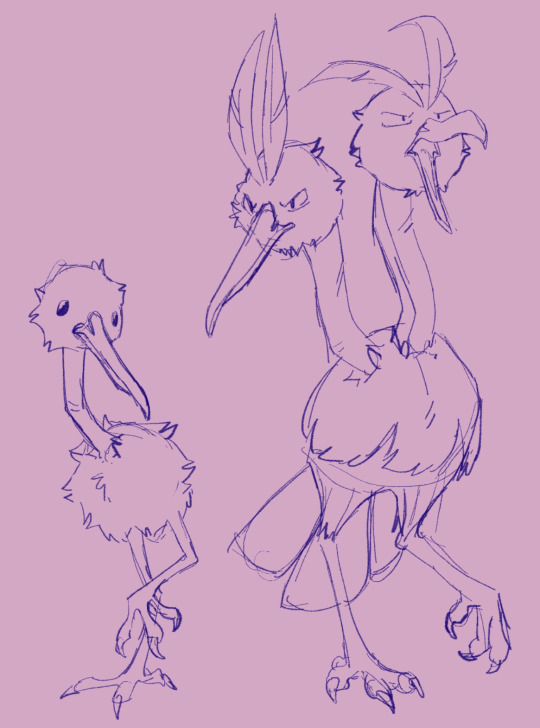
(this process can indeed lead to an inverse of polycephaly, in which the two heads of the doduo fail to separate while in development. while rare, this condition is rarely fatal, and dodrio evolving from single-headed doduo tend to be two-headed. note how the dodrio's heads are asymmetrical, with one middle and one left head.)
girafarig does not develop by partial fission- the anterior and posterior heads develop separately, just the same as you develop two of each limb, girafarig develops two heads.
in cases where a pokemon gains more heads as it evolves, such as in dodrio and zweilous, the process is somewhat similar to how it happens in embryos- the head essentially separates into two in the split-second process of instantaneous evolution, with new growth making up the material lost to each head (or in hyderigon's case, the middle head keeping all the brain). in doduo->dodrio and zweilous->hydreigon only one of the two heads separates: the right head in doduo, and the left in zweilous. you can see in the two-headed dodrio above that the singular "right" head split into the middle and right heads, leaving a "blank" space where the left head would be.
you also mentioned the various mythos surrounding multi-headed creatures- indeed, some think that mythological beasts like hades' hellish houndoom cerberus may have been inspired by real-life examples of polycephaly, though we don't know for sure. cases of polycephaly are indeed extremely rare, so it'd be entirely understandable for folks in ancient times to think they're some sort of legendary beast, and you can find records of conjoined twin animals labeled as miracles or similar in some medieval texts.
#AWHHHH!!! what a sweetie#that's interesting that the horns grew in different ways i wonder why#lovely art thank you for sharing! :]#pkmn#pkmn irl#pkmn rp#houndoom
182 notes
·
View notes
Note
I noticed awhile back that my grandmothers new pet sneasel has a little splotch of white fur covering her upper snout. I’ve never seen a sneasel with that marking before and asked my grandma about it, and she told me that she was born with it. I thought it was super cool Pokémon could be born with little distinctions like that! Do you know of any other examples of that popping up? Or is my grannies sneasel unique?
yep, small differences in color and pattern are a common sight across most pokemon species! this is especially prominent in those popularly bred, since folks select for things like interesting coat patterns or unique colors. very domestic pokemon like eevee, rockruff, or the many 'starter' pokemon are some of the most common this is seen in, since such traits can be selected against in the wild, decreasing their occurrence, while they are often seen as desirable in pets.
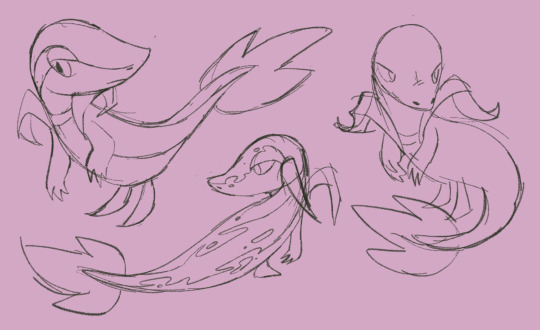
(a couple varieties of selectively-bred snivy, differentiated only by appearance- typical, broken stripe, and solid-color.)
white patches in particular are a common kind of pigment difference- leucism is the overall term for partial loss of pigment (different from albinism, though) which can include piebaldism. piebald organisms have blotchy patches of pigment loss across their body. you may also be familiar with vitiligo, which can look very similar to piebaldism, but are fundamentally different conditions.
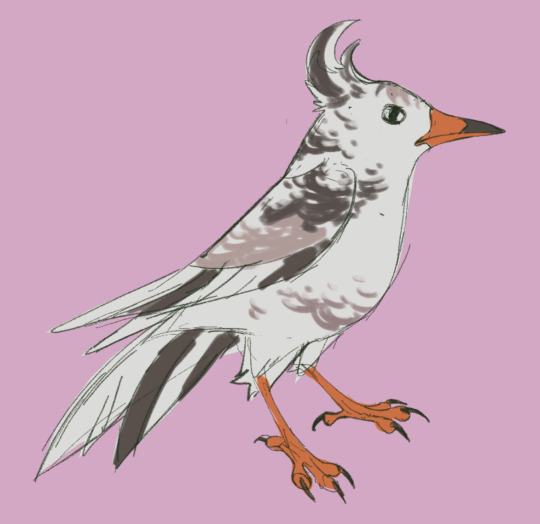
(a piebald staravia. leucism isn't a super uncommon sight in the wild, with birdwatchers in particular recording many instances.)
that said, i think i may have a specific explanation for why a sneasel would have a white patch, depending on where your granny's sneasel traces its ancestry. up until the mid-1800s or so, there were two varieties of sneasel- johtonian and hisuian (hisui being an older name for the sinnoh region). johtonian sneasel is the variety we have today, ice/dark type with black fur and red "feathers" which evolves into weavile. hisuian sneasel, on the other hand, was poison/fighting type with white and purple fur and "feathers", and it evolved into the now entirely extinct pokemon sneasler (alas, i don't think there's ever been a "sneaslest").

in the early 1800s, johtonian sneasel were introduced to sinnoh's frigid northern areas by people moving into the area. or, perhaps more apocryphal, even by "anomalies in space and time" as noted by a contemporary ecologist. while not exactly provable, there are indeed some records from the time of similar-sounding events, and it isn't like sinnoh nor johto are unfamiliar to their share of time-bending myths and phenomena, thanks to the legendary dialga and celebi. so, hey, maybe it was time travel. or both time travel and more mundane means. or maybe not time travel
these johtonian sneasel and weavile became an invasive species in the region, quickly acclimating to the area and coming into direct competition with hisuian sneasel and sneasler for food and territory. sneasler was known to breed infrequently- only once every few years- so they were particularly susceptible to lowering populations causing more collapse. the johtonian sneasel also proved to be more aggressive, and together with increasing human population drove the more solitary variety into smaller and smaller areas, until its eventual extinction, with the last known sneasler passing away in 1867.
however, during the time in which the two varieties did overlap, they uncommonly interbred. as a result, it isn't too odd to see sneasel/weavile from sinnoh today with patches or white or purple in their fur or "feathers", and veeery rarely even one that has one of the hisuian sneasel's typings (i REALLY need to expand on how typing works sometime soon). all that is to say- if your granny's sneasel or its ancestors are from sinnoh, the white splotch could be a result of hisuian sneasel heritage. it could also just be regular patches of pigmentation loss, as mentioned before, especially if the sneasel traces its ancestry outside of sinnoh.
264 notes
·
View notes
Note
I noticed awhile back that my grandmothers new pet sneasel has a little splotch of white fur covering her upper snout. I’ve never seen a sneasel with that marking before and asked my grandma about it, and she told me that she was born with it. I thought it was super cool Pokémon could be born with little distinctions like that! Do you know of any other examples of that popping up? Or is my grannies sneasel unique?
yep, small differences in color and pattern are a common sight across most pokemon species! this is especially prominent in those popularly bred, since folks select for things like interesting coat patterns or unique colors. very domestic pokemon like eevee, rockruff, or the many 'starter' pokemon are some of the most common this is seen in, since such traits can be selected against in the wild, decreasing their occurrence, while they are often seen as desirable in pets.

(a couple varieties of selectively-bred snivy, differentiated only by appearance- typical, broken stripe, and solid-color.)
white patches in particular are a common kind of pigment difference- leucism is the overall term for partial loss of pigment (different from albinism, though) which can include piebaldism. piebald organisms have blotchy patches of pigment loss across their body. you may also be familiar with vitiligo, which can look very similar to piebaldism, but are fundamentally different conditions.

(a piebald staravia. leucism isn't a super uncommon sight in the wild, with birdwatchers in particular recording many instances.)
that said, i think i may have a specific explanation for why a sneasel would have a white patch, depending on where your granny's sneasel traces its ancestry. up until the mid-1800s or so, there were two varieties of sneasel- johtonian and hisuian (hisui being an older name for the sinnoh region). johtonian sneasel is the variety we have today, ice/dark type with black fur and red "feathers" which evolves into weavile. hisuian sneasel, on the other hand, was poison/fighting type with white and purple fur and "feathers", and it evolved into the now entirely extinct pokemon sneasler (alas, i don't think there's ever been a "sneaslest").

in the early 1800s, johtonian sneasel were introduced to sinnoh's frigid northern areas by people moving into the area. or, perhaps more apocryphal, even by "anomalies in space and time" as noted by a contemporary ecologist. while not exactly provable, there are indeed some records from the time of similar-sounding events, and it isn't like sinnoh nor johto are unfamiliar to their share of time-bending myths and phenomena, thanks to the legendary dialga and celebi. so, hey, maybe it was time travel. or both time travel and more mundane means. or maybe not time travel
these johtonian sneasel and weavile became an invasive species in the region, quickly acclimating to the area and coming into direct competition with hisuian sneasel and sneasler for food and territory. sneasler was known to breed infrequently- only once every few years- so they were particularly susceptible to lowering populations causing more collapse. the johtonian sneasel also proved to be more aggressive, and together with increasing human population drove the more solitary variety into smaller and smaller areas, until its eventual extinction, with the last known sneasler passing away in 1867.
however, during the time in which the two varieties did overlap, they uncommonly interbred. as a result, it isn't too odd to see sneasel/weavile from sinnoh today with patches or white or purple in their fur or "feathers", and veeery rarely even one that has one of the hisuian sneasel's typings (i REALLY need to expand on how typing works sometime soon). all that is to say- if your granny's sneasel or its ancestors are from sinnoh, the white splotch could be a result of hisuian sneasel heritage. it could also just be regular patches of pigmentation loss, as mentioned before, especially if the sneasel traces its ancestry outside of sinnoh.
264 notes
·
View notes
Note
(@icetypelover) Hello, since biology is your thing I wanted to ask, how uncommon is a mutation where a Pokémon has two heads? I've seen it happen in Ekans and similar Pokémon rarely, but someone I know has a two-headed Houndoom, he was born with them. He's a gift from her father, back when he was a little Houndour pup, he's very well raised and gentle, though some fire can leak from his mouth when he's excited.
He's from a family of breeders who have been working with her father's family for generations where Houndoom are a Pokémon of choice, and they can't remember if it has ever happened before. The heads don't snap at each other and he's given a bit more food than a Houndoom his size would need since he has two brains, split in half so each head can eat, and he has no health issues.
I'm curious because there are two mythos I know, of Houndoom-like creatures with two and three heads, so it has to come from somewhere right? Since they're both represented as similar to Houndoom, does that mean it's maybe a mutation that can happen not so impossibly rare you wouldn't believe it in Houndoom?
wow, that's very fortunate that the fellow's gotten one just fine with two heads! extremely cool, what an exceptional lil guy, i'm glad the two get along.
polycephaly (literally "multiple headed") is a condition found all over the animal kingdom- including in humans!- and it isn't actually a mutation (with a notable exception we'll get to later). mutations specifically refer to changes in the genetic code- whether that's the flipping of a base pair, duplication of chromosomes, or so on- while polycephaly is actually a way that conjoined twinning can be expressed.
so, identical twins. identical (also called monozygotic) twins happen when a fertilized egg splits into two separate wholes at some point early in development- compare with "typical" development, where 1 egg + 1 sperm = 1 baby. identical twins happen when 1 egg + 1 sperm = 2 baby. compare with fraternal (or dizygotic) twins, which are formed from two separate eggs fertilized by two separate sperm. identical twins share a genetic code while fraternal twins do not (like any other sort of sibling). identical twins aren't super uncommon, though their rate of occurrence changes depending on where in the world you go.
now, usually this separation of the zygote into 2 embryos is complete. rarely, though, this splitting happens particularly late and doesn't quite finish, resulting in the two twins being connected in some fashion. this can result in an organism with one body and two heads, such as in your houndoom example, but can express in tons of different ways- for example, you may be familiar with the term "siamese twins" for conjoined twins: this originates from a famous pair of conjoined human twins from 1800's siam, chang and eng bunker, who were joined around the chest. in other cases, twins can be fused at the back of the head, the abdomen, the back, and plenty of other configurations.
survivability of these conditions varies wildly. some are easily separated, some live fine while conjoined, some must be separated for either of the two to survive, and unfortunately some are unable to survive at all, dying soon after birth.
the last case is usually what happens with two-headed organisms (something something, twice as many stars), but obviously, there are exceptions. while rare, organisms (of any sort- it's most famous in reptiles as you mentioned, but mammals (including humans!) can obviously exhibit it too) can live with these conditions as well.
also worth noting- when two complete heads are present, two complete brains are present! they may share organs and sensation, but the brains do function independently- so it's good that in your example the two get along! two-headed examples of less social species will often be much more antagonistic towards one another, since the two heads can recognize their counterparts as potential competitors or aggressors. this can cause problems in wild pokemon, who may waste precious time and energy squabbling over who gets to eat something that's going to the same stomach anyways (assuming the individuals share a stomach- sometimes there are two), leaving them vulnerable to attack.

(you may be familiar with 12-string, a polycephalic seviper(s) owned by virbank gym leader roxie, who famously featured in some particularly intense PWT matches- two heads means two sets of venom glands, which means REALLY effective poison type attacks!)
this also raises the question of individuality- whether polycephalic organism(s) are considered one or two beings- and perspectives on this vary. some polycephalic twins consider themselves two separate people, while some consider themself one. in what way you consider polycephalic organisms without the ability to self-define in that way is up to you, really (which is to say, if a person with two heads considers themself one person, they are one person, and vice versa, but most nonhuman animals can't decide that for themselves and probably don't care how you refer to them).
now, uh, back to pokemon specifically, and those notable exceptions i mentioned. while polycephaly is exceptional in the vast majority of species, there are of course a few where having multiple heads is the norm: doduo/dodrio, deino/zweilous/hydreigon, and girafarig/farigiraf (there are a few others- like weezing or cherubi- but i'm talking about animals specifically here. also not to be confused with conglomerate pokemon like dugtrio or magneton, which are multiple separate individuals working as one). these instances are indeed genetically programmed.
the mechanism by which these pokemon develop their multiheadedness varies. doduo could be considered to be a conjoined twin- the zygote's partial split happens in much the same way, though enforced by genetics.

(this process can indeed lead to an inverse of polycephaly, in which the two heads of the doduo fail to separate while in development. while rare, this condition is rarely fatal, and dodrio evolving from single-headed doduo tend to be two-headed. note how the dodrio's heads are asymmetrical, with one middle and one left head.)
girafarig does not develop by partial fission- the anterior and posterior heads develop separately, just the same as you develop two of each limb, girafarig develops two heads.
in cases where a pokemon gains more heads as it evolves, such as in dodrio and zweilous, the process is somewhat similar to how it happens in embryos- the head essentially separates into two in the split-second process of instantaneous evolution, with new growth making up the material lost to each head (or in hyderigon's case, the middle head keeping all the brain). in doduo->dodrio and zweilous->hydreigon only one of the two heads separates: the right head in doduo, and the left in zweilous. you can see in the two-headed dodrio above that the singular "right" head split into the middle and right heads, leaving a "blank" space where the left head would be.
you also mentioned the various mythos surrounding multi-headed creatures- indeed, some think that mythological beasts like hades' hellish houndoom cerberus may have been inspired by real-life examples of polycephaly, though we don't know for sure. cases of polycephaly are indeed extremely rare, so it'd be entirely understandable for folks in ancient times to think they're some sort of legendary beast, and you can find records of conjoined twin animals labeled as miracles or similar in some medieval texts.
#art#pkmn#seviper#doduo#dodrio#note as said above polycephaly and other forms of conjoined twinning are real things that happen to real people and i want to handle it sen#sitively because of that. ive tried to but if anything ive said comes off as rude or callous do please call me on it#pkmn irl#pkmn rp
182 notes
·
View notes
Text
my hubris. my arrogance
#'oh this dude knocked out his OWN two lead pokemon by quick-claw exploding turn 1 ive got this haha'#Thats The Devil Talking.#pkmn irl#pkmn rp
21 notes
·
View notes
